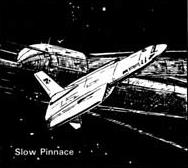Smallcraft
Small Craft: Vessels under a hundred tons are considered to be small craft. [1]
- Smallcraft are non-jump spacecraft under a 100 dTons in displacement.
- There are two primary types of smallcraft:
- Combatant Smallcraft usually known as Fighters
- Noncombatant Smallcraft usually known as Utility Craft
- Smallcraft meant to be carried internally in other, larger ships are often called subcraft.
- Various standard types of small craft exist.
Library Data Referral Tree[edit]
Please refer to the following AAB Library Data for more information:
Starship:
- Advanced Ship Classifications
- Ship Mission Code / Supraclass
- Ship Type Code / Superclass
- Ship Class Code / Class
- Model (TL)
- Bloc (Lot)
- Basic Ship Classifications
- Adventure Class Ship (Auxiliary Class Ship)
- Battle Class Ship (Bulk / Subcapital Class Ship)
- Capital Ship (Capital Class Ship)
- Fleet Class Ship (Capital Class Ship)
- Size-Role Classification
- Subcapital Ship (Small & Large Battle Class Ships)
- QSP
- USP
- World Class Ship
- NAFAL (STL) - (Not As Fast As Light) / (Slower Than Light)
- Light Speed (c)
- FTL - (Faster Than Light) - "Superluminal"
-
- Light-second (ls)
- Light-minute (lm)
- Light-hour (lh)
- Light-day (ld)
- Light-week (lw)
- Light-year (ly)
- Parsec (pc)
Description (Specifications)[edit]
Each small craft design is intended to be as useful as possible. As a result, smallcraft descriptions cover the basic performance of the craft, and indicates price, crew, and other details. Each craft also has a feature called excess space: this interior tonnage may be used by the purchaser for a wide variety of purposes. In effect, when the craft is procured, it is customized by the purchaser for some specific use. Any fitting or combination of fittings available may be specified for a standard design small craft. The prices, however, are ignored, and are considered to be included in the standard design price. [1]
Shuttling between planets, small non-starships run errands, make deliveries. and generally do much of the dirty work that larger craft can't or won't do. Small craft displace less than 100 dtons and are thus incapable of interstellar flight.
[edit]
These vary in tonnage and in their intended function or role in fleet maneuvers and tactics. The security of the state is usually the primary design imperative. [2]
| Ship Classification by Size | |||||
|---|---|---|---|---|---|
| # | Type | Tonnage | Examples | Remarks | |
| 1. | Smallcraft | 0 - 99 tons | Smallcraft are typically Subcraft, designed to be carried by carrier craft. | ||
| 2. | Spacecraft | 100 tons or larger |
Spacecraft are in-system vessels, lacking interstellar drives.
| ||
| 3. | Adventure Class Ships (ACS) | 100 tons - 2,400 tons | Adventure Class ships are usually jump-capable.
| ||
| 4. | Battle Class Ships (BCS) | 2,500 tons - 250 ktons | Battle Class ships are warships. They are usually jump-capable.
| ||
| 5. | Fleet Class Ships (FCS) | 250 ktons - 1 Mton |
Fleet Class ships are primary warships. They are usually jump-capable.
| ||
| 6. | World Class Ships (WCS) | > 1 Mton | Loeskalth planetoid generation ship. | World Class ships are beyond expensive and represent suprapolity-level investment.
| |
Escort Combatants (Secondary) - The Lightcraft Hierarchy[edit]
A number of smallcraft and ACS combatants exist:
- Smallcraft (F or U) (0 - 99 tons) (* System craft / non-Jump *)
- Fighter: Interceptor / Picket (FD / FE / FP / FR) (10 - 50 tons)
- Gunboat / Torpedo Boat (GB / MB / BD / BE) (40 - 99 tons)
- Light Sloop (ESL) (50 - 99 tons)
- Bigcraft (W or Other) (100 tons or larger) (* System vessel / non-Jump *)
- Defense Boat (SDB) (100 - 1000 tons)
- Sloop-of-War (ESB) (100 - 600 tons)
- Brig (EB) (400 - 1000 tons)
- System Defense Vessel (SDV) (1000 - 2,499 tons or larger)
- Escort (E) (100 - 2,499 tons)
- Jump-Sloop (ESJ) (100 - 600 tons)
- Close Escort (EC) (300 - 600 tons)
- Corvette (EG) (300 - 800 tons)
- Escort Frigate (EF) (500 - 2000 tons)
- Gunned Frigate (G) (500 - 2000 tons)
- Destroyer (D) (1,000 - 2,499 tons or larger)
- Colonial Cruiser (C) (1,000 - 2,499 tons or larger)
History & Background (Dossier)[edit]
There are eight standard designs available; each design plan is available for Cr100. All take approximately twelve months to build. All are streamlined, and can enter atmospheres. All can operate with unrefined fuel; they have fuel scoops which allow them to skim fuel from a gas giant. [1]
Standard plans are available for the following small craft:
- 10-ton Fighter
- 20-ton Launch
- 30-ton Ship's Boat
- 30-ton Slow Boat
- 40-ton Pinnace
- 40-ton Slow Pinnace
- 50-ton Cutter
- 95-ton Shuttle
References & Contributors (Sources)[edit]
| This article has metadata. |
- Marc Miller. Starships (Game Designers Workshop, 1977), —.
- Marc Miller. Imperial Encyclopedia (Game Designers Workshop, 1987), —.
- Mike Jackson. "Traveller Craft." Third Imperium 10 (1988): —.
- Mike Jackson. "Traveller Craft." Third Imperium 11 (1988): —.
- S.R. Greene. SGS: Imperial Small Craft (Seeker Gaming Systems, 1992), —.
- S.R. Greene. SGS: Imperial Small Craft Vol. 2 (Seeker Gaming Systems, 1992), —.
- Frank Chadwick, Dave Nilsen. Traveller: The New Era (Game Designers Workshop, 1993), 378.
- Dave Nilsen. Reformation Coalition Equipment Guide (Game Designers Workshop, 1994), —.
- Jason Kemp. Stellar Reaches 04 (FLTGames Gaming Group, 2006), —.
- ↑ Jump up to: 1.0 1.1 1.2 Marc Miller. Starships (Game Designers Workshop, 1977), 17.
- ↑ Information provided to the library by Ronald B. Kline, Jr.
